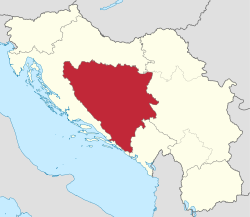PR Bosnia and Herzegovina
| Socialist Republic of Bosnia and Herzegovina Socijalistička Republika Bosna i Hercegovina Социјалистичка Република Босна и Херцеговина |
||||||
| Constituent republic of Yugoslavia | ||||||
|
||||||
|
||||||
| Location of Bosnia and Herzegovina in Yugoslavia. | ||||||
| Capital | Sarajevo | |||||
| Government | Socialist republic | |||||
| President | ||||||
| • | 1945–1946 (first) | Vojislav Kecmanović | ||||
| • | 1990–1992 (last) | Alija Izetbegović | ||||
| Prime Minister | ||||||
| • | 1945–1948 (first) | Rodoljub Čolaković | ||||
| • | 1990–1992 (last) | Jure Pelivan | ||||
| Legislature | National Assembly | |||||
| Historical era | Cold War | |||||
| • | ZAVNOBiH | 25 November 1943 | ||||
| • | Creation of Herzeg-Bosnia | 18 November 1991 | ||||
| • | Creation of Republika Srpska | 9 January 1992 | ||||
| • | Independence referendum | 1 March 1992 | ||||
| • | Outbreak of Bosnian War | 5 April 1992 | ||||
| • | Independence | 6 April 1992 | ||||
| Area | ||||||
| • | 1991 | 51,129 km2(19,741 sq mi) | ||||
| Population | ||||||
| • | 1991 | 4,377,053 | ||||
| Density | 85.6 /km2 (221.7 /sq mi) | |||||
| Today part of |
|
|||||
The Socialist Republic of Bosnia and Herzegovina (Serbo-Croatian: Socijalistička Republika Bosna i Hercegovina (SR BiH) / Социјалистичка Pепублика Босна и Херцеговина (СP БиХ)) was one of the six constituent federal units forming the Socialist Federal Republic of Yugoslavia. It was a predecessor of the modern-day Bosnia and Herzegovina state, and existed between 1945 and 1992, included in Yugoslavia as a condominium. It was subsequently given the higher status of a Socialist Republic, under strict terms of hegemonist consociationalism known as "ethnic key" (Bosnian: nacionalni ključ), where balance in the political representation of ethnic groups (Serbs, Croats and Bosniaks) was enforced. The capital city was Sarajevo, which remained the capital following independence. The Socialist Republic was dissolved in 1990 when it abandoned its communist institutions and adopted free market ones, as the Republic of Bosnia and Herzegovina which declared independence from Yugoslavia in 1992. The Government of Bosnia and Herzegovina was, up to 20 December 1990, in the hands of the League of Communists of Bosnia and Herzegovina.
The borders of SR Bosnia and Herzegovina were almost identical to the ones Bosnia had during the period of Austro-Hungarian rule that lasted until 1918. That year Bosnia became part of the Kingdom of Yugoslavia and during that period the territory was divided among banovinas. When SR Bosnia and Herzegovina was formed, it included what were the territories of most of Vrbas Banovina, the western part of Drina Banovina, the northwestern part of Zeta Banovina, and the eastern parts of Banovina of Croatia.
...
Wikipedia



